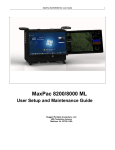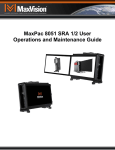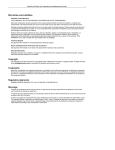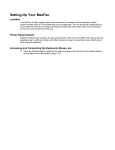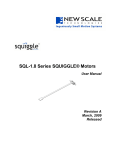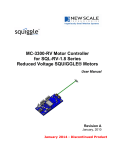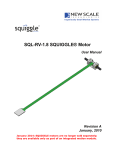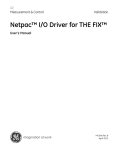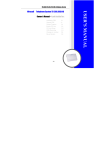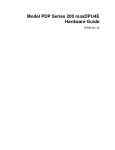Download MaxCube II User Manual
Transcript
MaxCube II User Operation and Maintenance Guide MaxCube II User Setup and Maintenance Guide Rugged Portable Computers, LLC 495 Production Avenue Madison, AL 35758, USA i ii MaxCube II User Operation and Maintenance Guide Warranties and Liabilities MaxVision Corporation warrants that the Product, in the course of its normal use, will conform to MaxVision's specifications and be free from defects in material and workmanship for a period of twelve (12) months from the date of the original sale. Such warranty commences on the purchase date appearing on the invoice. The original end user is entitled to customer support through telecommunication during normal MaxVision business hours and email support to be responded to as support staff are available. Such support shall be limited to hardware operations and the software required operating such hardware. Upon written request and subject to the availability of MaxVision personnel, additional support may be provided by MaxVision in its sole discretion on a time and materials basis. Limited Warranty for Software. MaxVision warrants to the original end user only that the Software as delivered at the time of purchase will perform in MaxVision hardware, and that the original diskettes or compact disks are free from defects in material and workmanship under normal use, for a period of thirty (30) days from the date of original sale, provided the Software is used with a MaxVision unit. MaxVision makes no warranty that the Software will work in combination with any hardware or software products provided by third parties, that the operation of the Software will be uninterrupted or error-free, or that all defects in the Software will be corrected. This limited warranty is void if failure of the Software has resulted from accident, abuse, or misapplication. MaxVision's entire liability, and your sole and exclusive remedy shall be, at MaxVision's option, either to (a) correct or help you work around or avoid a reproducible Error or (b) replace defective diskettes or compact disks. Any replacement Software will be warranted for the remainder of the original Limited Software Warranty Period. Limited Warranty for the Product. MaxVision warrants to the original end user only that all Products sold by MaxVision will be free from defects in material and workmanship and conform substantially to the applicable standards set forth in the Documentation, under normal use, for a period of 365 days from the date of original sale. This limited warranty is void if failure of the Product has resulted from accident, abuse, or misapplication. If MaxVision confirms a Product is defective after you have obtained a Return Materials Allowance Number for such Product and, at your expense, have returned the Product to MaxVision for inspection, MaxVision will, at its election, repair or replace such Product at no charge to you. Replacement Product may be either new or remanufactured. In the event that the Product returned is not defective, you will be responsible for freight costs for return shipment to you. The foregoing warranty shall not apply to Product that has been (a) damaged by accident, Acts of God, shipment, improper installation, abnormal physical or electrical stress, misuse or misapplication, as determined by MaxVision in its sole reasonable discretion, or (b) modified without MaxVision's express written acceptance of such modification for warranty purposes. MaxVision reserves the right to charge additional fees for repairs or replacements performed outside the Warranty Period. Any replaced or repaired components, subassemblies or units as well as spare parts are warranted for thirty (30) days or the remainder of the original warranty period, whichever is longer. MaxVision shall not be responsible for any software, firmware, information or memory data of yours contained in, stored on, or integrated with any Products returned to MaxVision pursuant to any warranty under this Agreement. Disclaimer of Warranties. EXCEPT AS SPECIFICALLY PROVIDED ABOVE, NEITHER MAXVISION NOR ITS LICENSORS OR SUPPLIERS PROVIDES ANY WARRANTY OF ANY KIND FOR THE SOFTWARE OR THE PRODUCT, WHETHER EXPRESS, IMPLIED, STATUTORY OR OTHERWISE, INCLUDING BUT NOT LIMITED TO WARRANTIES OF MERCHANTABILITY, FITNESS FOR A PARTICULAR PURPOSE, AND NON-INFRINGEMENT OF THIRD PARTY RIGHTS. EXCEPT AS SET FORTH IN THIS AGREEMENT, THE ENTIRE RISK AS TO THE QUALITY AND PERFORMANCE OF THE SOFTWARE AND THE PRODUCT IS WITH YOU. If a disclaimer of implied warranties is not permitted by law, the duration of any such implied warranty is limited to ninety (90) days from the date of purchase by the original end user. Some jurisdictions do not allow the exclusion of implied warranties or limitations on how long an implied warranty may last, so such limitations or exclusions may not apply to you. This limited warranty gives you specific legal rights, and you may also have other rights which vary from jurisdiction to jurisdiction. Liability Exclusions and Limitations. IN NO EVENT SHALL MAXVISION OR ITS LICENSORS OR SUPPLIERS BE LIABLE FOR ANY INDIRECT, SPECIAL, INCIDENTAL, EXEMPLARY OR CONSEQUENTIAL DAMAGES OF ANY KIND (INCLUDING LOST PROFITS, LOSS OF USE OR INTERRUPTION OF BUSINESS), OR FOR LEGAL FEES, ARISING OUT OF THE USE OF THE SOFTWARE OR THE PRODUCT, REGARDLESS OF THE FORM OF ACTION, WHETHER IN CONTRACT, TORT (INCLUDING NEGLIGENCE), STRICT PRODUCT LIABILITY OR OTHERWISE, EVEN IF MAXVISION OR ITS LICENSORS OR SUPPLIERS HAVE BEEN ADVISED OF THE POSSIBILITY OF SUCH DAMAGES. IN NO EVENT WILL COMPANY'S AGGREGATE LIABILITY HEREUNDER EXCEED THE PURCHASE PRICE PAID BY YOU. This limitation shall apply notwithstanding any failure or inability to provide the limited remedies set forth above. Some jurisdictions do not allow the exclusion or limitation of incidental or consequential damages, so the above limitation(s) or exclusion(s) may not apply to you. MaxCube II User Operation and Maintenance Guide iii Proprietary Rights-Contracts with Certain U.S. Government Agencies. If the Software is acquired under the terms of a Department of Defense or civilian agency contract, the Software is "commercial item" as that term is defined at 48 C.F.R. 2.101 (Oct. 1995), consisting of "commercial computer software" and "commercial computer software documentation" as such terms are used in 48 C.F.R. 12.212 of the Federal Acquisition Regulations and its successors and 48 C.F.R. 227.7202-1 through 227.7202-4 (June 1995) of the DoD FAR Supplement and its successors. All U.S. Government end users acquire the Software with only those rights set forth in this Agreement. Export Restrictions. You acknowledge that the laws and regulations of the United States restrict the export and re-export of certain commodities and technical data of United States origin, including the Product and the Software, in any medium. You agree that you will not knowingly, without prior authorization if required, export or re-export the Software or the Product in any medium without the appropriate United States and foreign government licenses. Severability. You acknowledge and agree that each provision of this Agreement that provides for a disclaimer of warranties or an exclusion or limitation of damages represents an express allocation of risk, and is part of the consideration of this Agreement. Invalidity of any provision of this Agreement shall not affect the validity of the remaining provisions of this Agreement. General. This Agreement is the entire agreement between you and MaxVision relative to the Product and the Software, and supersedes all prior written statements, proposals or agreements relative to its subject matter. It may be modified only by a writing executed by an authorized representative of MaxVision. No MaxVision reseller or sales representative is authorized to make any modifications, extensions or additions to this Agreement. This Agreement is governed by the laws of the State of Alabama without application of the principles of conflicts or choice of laws. The application of the United Nations Convention on Contracts for the International Sale of Goods to this Agreement is expressly excluded. Copyright The materials in this document are the copyrighted works of MaxVision Corporation, copyright © 2005-2007. All rights reserved. Email [email protected] for permission to duplicate and otherwise re-use. Trademarks MaxVision, and MaxPac are registered trademarks, and MaxCube, MaxPro, and TeraPac are trademarks, of MaxVision Corporation. Microsoft and Windows are registered trademarks of Microsoft Corporation. Intel and Pentium are registered trademarks and Xeon is a registered trademark of Intel Corporation. Other trademarks and registered trademarks are the property of their respective owners. Regulatory Approvals EN60950, EN55024, EN55022, FCC, Part 15, EN61000-3-2 & EN61000-3-3. Warnings Changes or modifications to this device that are not approved by the party responsible for compliance could void the user’s authority to operate the equipment. To reduce the risk of electrical shock, do not attempt to open the device unless instructed to do so. Do not use any tool for purposes other than instructed. A Lithium Ion battery is included with the system motherboard. This battery is used for the Real Time Clock (RTC) circuit. The expected lifetime of the battery is approximately 5 years. There is a danger of explosion if this battery is incorrectly replaced. Replace only with the same or equivalent type recommended by the motherboard manufacturer. Dispose of used batteries according to the manufacturer’s instructions. iv MaxCube II User Operation and Maintenance Guide Contents Warranties and Liabilities ..................................................................................................................................... ii Copyright ............................................................................................................................................................. iii Trademarks ......................................................................................................................................................... iii Regulatory Approvals .......................................................................................................................................... iii Warnings ............................................................................................................................................................. iii Chapter 1: Quick Start Setup.................................................................................................................................. 1 Documentation Conventions ............................................................................................................................... 2 Inspecting the Shipment...................................................................................................................................... 2 Unpacking the MaxCube ..................................................................................................................................... 3 Setting-Up the MaxCube ..................................................................................................................................... 5 Powering-Up Your MaxCube .............................................................................................................................. 9 “Dos and Don’ts” ............................................................................................................................................... 10 Setting-Up the Graphics ....................................................................................................................................... 10 Adjusting the Display......................................................................................................................................... 11 Chapter 2: Handling Removable Media ............................................................................................................... 12 Introduction ....................................................................................................................................................... 13 Removing and Storing the System Drives ........................................................................................................ 13 Removing and Storing the Data-Drive Magazine ............................................................................................. 14 Chapter 3: Module Replacement/Upgrade Procedures ..................................................................................... 16 Introduction ....................................................................................................................................................... 17 Required Tools and Techniques ....................................................................................................................... 17 Names and Types of Screws ............................................................................................................................ 17 Motherboard Diagrams ..................................................................................................................................... 18 Removal of optional display/keyboard assembly .............................................................................................. 20 Adding/Replacing Memory Sticks ..................................................................................................................... 26 Removing/Replacing PCIe Cards ..................................................................................................................... 28 Appendix A: Creating and Using Backup Images (Including Restoring Your OS) ......................................... 31 Introduction ....................................................................................................................................................... 31 Appendix B: Regular System Maintenance ........................................................................................................ 41 Maintaining (Cleaning) the Filter ....................................................................................................................... 41 Resetting the Motherboard BIOS ...................................................................................................................... 44 Replacing the Lithium Battery ........................................................................................................................... 45 Appendix C: Screws and Required Tools ........................................................................................................... 46 Screws............................................................................................................................................................... 46 Required Tools .................................................................................................................................................. 47 Appendix D: Contacting MaxVision Support (RMA and Serial Numbers) ....................................................... 48 Repairing/Replacing Products/Accessories ...................................................................................................... 48 Contacting Technical Support and RMA Numbers ........................................................................................... 48 MaxCube II User Operation and Maintenance Guide Chapter 1: Quick Start Setup 1 2 MaxCube II User Operation and Maintenance Guide Documentation Conventions Icons The information icon is used to annotate important information. The exclamation icon is used to annotate cautionary information. Italics font is used for emphasis, book titles, commands, and path and file names. Bold may be used to emphasize text, highlight menu items, and denote the titles of dialog boxes. Menu > Command identifies the path used to select a menu command. Courier font is used for program listings and for any text messages that the software displays on the screen. Note: describes important information, warnings, or unique commands. “Select” means click the left mouse button on the indicated item. “Click-left” (or just “click”) means click the left mouse button on the indicated item. “Click-middle” means click the middle mouse button on the indicated item. “Click-right” means click the right mouse button on the indicated item. “Double-click” means click twice consecutively with the left mouse button. “Drag-left” (or just “drag”) means press and hold the left mouse button on the indicated item, then move the cursor (pointer) to the destination and release the button. “Shift-click-left” means press and hold the <Shift> key then click the left mouse button on the indicated item. “Ctrl-click-left” means press and hold the <Ctrl> key then click the left mouse button on the indicated item. Fonts Inspecting the Shipment MaxCube systems are packaged to withstand the roughest of treatment during shipping. Any boxes, foam core padding, and anti-static bags should be stored safely away in case you need to ship the system for any reason in the future. Inspect the containers the system arrived in. If there is any unusual damage to the containers, make note of the damage on the delivery form and contact MaxVision support (see Appendix D for more details). MaxCube II User Operation and Maintenance Guide 3 Unpacking the MaxCube Note: MaxCube systems are always shipped in an associated Pelican case. The Pelican/MaxCube combination weighs approximately 70 lbs (more with display and netpac options). If you are unable to lift this weight safely, you should obtain assistance in unpacking and moving the system. 1) Clear an area on a desk or table on which to place your MaxCube system. 2) Place the Pelican case containing the MaxCube system on the floor near the desk or table. 3) Remove the packing slip from the outside of the Pelican case and save it for later use as discussed below. 4) Open the six latches securing the lid of the Pelican case as illustrated in Figure 1-1 Figure 1-1 Figure 1-2 5) Keeping your back straight, bending at the knees, and using your legs as much as possible, carefully slide the MaxCube out of the case with the assistance of the handles on the sides as illustrated in Figure 1-2 and place the system on the table. 6) Observe the area to the right of the unit compartments that contains the wheels as illustrated in Figure 1-3. Set the wheels aside. Open the flap under the wheels to retrieve documentation and software as illustrated in Figure 1-4. Figure 1-3 Figure 1-4 4 MaxCube II User Operation and Maintenance Guide 7) Observe the documentation pack, AC power and DC input cable (only needed if powered off of DC power) in Figure 1-5. Figure 1-5 8) Close the lid, and invert the Pelican case such that it is resting on its lid as illustrated in Figure 16. 9) Attach the four wheels as illustrated in Figures 1-7. Figure 1-6 Figure 1-7 MaxCube II User Operation and Maintenance Guide 5 Figure 1-8 10) When transporting the system in the future, you can use the Pelican case's collapsible handle to pull the case around (as illustrated in Figure 1-8). Note: In order to avoid damaging the Pelican case, you must detach and re-store the wheels in the case before shipping the MaxCube (see Figures 1-3 and 1-4). Check the Packing List and Confirm Documentation 1) Check the packing slip to ensure that everything is as you expect with regard to the main system. Pay particular attention to any special options you may have requested, such as number of disk drives, memory upgrades, and custom graphics subsystems. 2) Check the contents of the envelope containing the documentation associated with your system. – a basic MacCube documentation pack will include: Windows® license and CD-ROM. Motherboard manual. Recovery DVD. Setting-Up the MaxCube Location Your MaxCube system needs to be positioned in a location with the capacity to safely support at least 54 lbs. The unit should be unobstructed so as to permit the free flow of cooling air in through the intake filter and out via the exhaust vents. Cable Connections 1) The MaxCube in this document includes both the optional display/keyboard assembly and the Netpac base with 16port GbE switch and Cisco Security Appliance. The cables associated with these devices are shipped unplugged and bound together with a Velcro strap as illustrated in Figure 1-9. 6 MaxCube II User Operation and Maintenance Guide Figure 1-9 2) AC power input for the Netpac base is provided via the AC plug shown being connected in Figure 1-10. Figure 1-10 MaxCube II User Operation and Maintenance Guide 3) The DC power for the Netpac base is shown being connected in Figure 1-11. Notice the keying of this connector. Figure 1-11 4) Usually the keyboard USB is connected to the port illustrated in Figure 1-12. Do not change the keyboard USB connection without first shutting down the MaxCube. Figure 1-12 7 8 MaxCube II User Operation and Maintenance Guide 5) The network connection to the MaxCube motherboard is illustrated in Figure 1-14. Either port could be used. The optional Netpac base may also be used for the connection to your main network. Figure 1-13 6) Figure 1-14 shows the optional DC power input. Figure 1-15 shows the standard AC power input. Figure 1-14 Figure 1-15 Note: The AC power out connector (blue round connector shown in Figure 1-15) is primarily intended for use with a NetPac™ or TeraPac 3 unit. This connector provides the TeraPac 3 or NetPac with an uninterrupted power source via the optional MaxCube internal UPS unit. If required, you may use this connector to power a low-demand unit such as an external USBbased drive, for example. However, under no circumstances should you use this connector to power any high-demand equipment. MaxCube systems can be powered from AC or DC sources (optional). In the case of an AC source, the MaxCube's power supply is an auto-sensing 100 to 240 VAC, 50 to 60 Hz unit. In the case of a DC source, the MaxCube's power supply is an auto-sensing 20 to 32 VDC unit (80A inrush and 30A MaxCube II User Operation and Maintenance Guide 9 nominal at 28V). Ensure that the supplied power is sufficient, stable, and without spikes or surges for operation of your MaxCube and other required equipment. Opening the Display 1) The optional display is not latched; instead it is held securely by a friction hinge. In order to deploy the display, gently lift it into the vertical position as illustrated in Figures 1-16 and 1-17. Observe the integrated rugged keyboard. Figure 1-16 Figure 1-17 Powering-Up Your MaxCube 1) Press and release the soft power switch as illustrated in Figure 1-18. Figure 1-18 Figure 1-19 2) Due to extensive system initialization and verification checks, the BIOS boot-up process can take a significant amount of time, especially in the case of systems with large amounts of memory. In the case of a system containing 12 GB of RAM, for example, it can take 60 seconds before all three LEDs above the numerical keypad on the keyboard flash to indicate that the system is at a point where information should start to appear on the main display. Note: If nothing appears on the main display, the fact that the three LEDs flash on the keyboard indicate that the system is alive. 10 MaxCube II User Operation and Maintenance Guide “Dos and Don’ts” 1) Always disconnect the external power source (AC or DC depending in your environment) when removing or installing system components. 2) In the case of extreme dust conditions, it is imperative that you use (and maintain) the oil-based "Filter" supplied with your system (see also the discussions on maintaining this filter as presented later in this manual). Setting-Up the Graphics When you receive your MaxCube system, you will find that the graphics subsystem has been preinstalled with the following (recommended) characteristics: • Color Quality: Highest (32-bit) • Resolution: 1280 x 800 (assuming an optional 13.3” display) Irrespective of the configuration, the graphics on your system will have been custom pre-configured to suite your particular requirements. If you wish to modify these settings, right-mouse-click in an empty area of the desktop, select the Properties item from the resulting pop-up menu, select the Settings tab, and then vary the Color quality and Screen resolution values as required. MaxCube systems are available with a variety of different graphics cards depending on your unique application(s). The standard configuration employs a PCI Express-based NVIDIA Quadro family board. If you do have a special graphics card, you should consult the manual associated with this card (this manual will be included in your documentation package as discussed in Chapter 1) or contact MaxVision support (as discussed in Appendix D) for more information. MaxCube II User Operation and Maintenance Guide 11 Adjusting the Display Look carefully at the controls shown in Figure 1-20. Observe the power button located to the right of the power light-emitting diode (LED). This is an independent power button for the display. Pressing the MENU button will bring up a series of items on the screen. Use the up/down buttons to move between these items; press and release the SEL button to select that item; use the up/down buttons again to vary the settings; and press and release SEL button to accept the new settings. When you are finished, press the MENU button to exit the menu system. Figure 1-20 12 MaxCube II User Operation and Maintenance Guide Chapter 2: Handling Removable Media MaxCube II User Operation and Maintenance Guide 13 Introduction The MaxCube is ideal for high-security environments in which it is required to be able to remove and securely store sensitive data; the two system drives (which can be configured as a redundant / mirrored RAID 1 array if required) and eight-data-drive magazine are removable. Also, the removable nature of the eight-data-drive magazine makes the MaxCube an ideal system for high-definition (HD) video recording and editing applications. Removing and Storing the System Drives 1) Open the optional display screen (if present) and then gently pull the front air intake grill away from the system as illustrated in Figure 2-1. Figure 2-2 Figure 2-1 2) In order to remove the system set, unscrew the captured screws as illustrated in Figure 2-2 and then pull the disk away from the system as illustrated in Figure 2-3. Figure 2-3 14 MaxCube II User Operation and Maintenance Guide Removing and Storing the Data-Drive Magazine 1) Open the optional display screen (if present) and then gently pull the front air intake grill away from the system as illustrated in Figure 2-4. Figure 2-4 Figure 2-5 2) Observe the two spring-loaded release latches at either end of the data-drive magazine's quickrelease locking bar as shown in Figure 2-5 (the right-hand release latch is located just to the right of the fingers in this illustration. In order to remove the eight-disk data-drive magazine, pull these spring latches toward the center of the quick-release locking bar, lift the bar as illustrated in Figure 2-6, and pull the magazine away from the system as illustrated in Figure 2-7. Figure 2-6 Figure 2-7 3) When the locking bar has cleared the system, take a firm hold of the magazine as illustrated in Figure 2-7 and fully remove it from the system. 4) Store the magazine in a secure location. Note: As opposed to an 8-disk data-drive magazine, your system may be configured with one or two 4-disk magazines; one, two, three, or four 2-disk magazines; or one 4-disk magazine combined with one or two 2-disk magazines. MaxCube II User Operation and Maintenance Guide 15 5) A similar process is used to remove the optical drive. Unscrew the captured screws (these are not thumbscrews, so a screwdriver is normally required for field replacement of the optical drive) as illustrated in Figure 2-8 and 2-9. Figure 2-8 Figure 2-9 16 MaxCube II User Operation and Maintenance Guide Chapter 3: Module Replacement/Upgrade Procedures MaxCube II User Operation and Maintenance Guide 17 Introduction The instructions in this chapter describe how to replace and upgrade various modules in your MaxCube II system. Note: Generally speaking, you should only access the MaxCube internals under the direction of MaxVision support. In some cases, performing unauthorized procedures or using components that have not been tested and approved by MaxVision may invalidate your warranty. Note: Power-down your MaxCube system (shut down Windows®) and then remove the power cable before performing any of the procedures discussed in this chapter. Also please be aware of static discharge when working on your MaxCube. Ideally you should be wearing a properly grounded static strap; failing this, make sure to touch the metal part of the chassis to discharge any static prior to handling any delicate electronic parts. Note: When accessing the system internals and/or performing module upgrade procedures, you are quickly going to end up with a lot of screws and other small items. In order to keep track of things and to prevent misplacing any parts, it is strongly recommended to have a plastic container divided into small compartments and to label these compartments as you work. Required Tools and Techniques Most of the module replacement and upgrade procedures discussed in this chapter can be performed using only a pair of #1 (small tip) and #2 (regular tip) Phillips screwdrivers. However, some procedures will require additional tools as discussed in Appendix C. Note: It is extremely important that you use only high-quality tools so as to avoid any slippage and stripping of screw heads and threads. Furthermore, in order to avoid any slippage, it is VERY important to apply adequate force in the form of firm and steady pressure. See Appendix C for details on the tools required to service the system. Note: It is highly recommended that you use magnetized screwdrivers so as to prevent screws from dropping inside the case and/or aiding in retrieving them if they do drop inside the case. (If your screwdriver isn’t already magnetized, you can make it so by repeatedly “stroking” the blade with a permanent magnet. Note: For additional immunity to vibration, all screws in a MaxCube system are secured with removable blue LOCTITE. If you remove any screws, then you should reapply LOCTITE prior to replacing those screws. Names and Types of Screws MaxCube systems use a variety of different screw types. In order to help you follow the instructions in this chapter, details on these screws are provided in Appendix C. 18 MaxCube II User Operation and Maintenance Guide Motherboard Diagrams MaxCube II User Operation and Maintenance Guide 19 20 MaxCube II User Operation and Maintenance Guide Removal of optional display/keyboard assembly 1) In order to gain access to the main internal chassis the optional display/keyboard assembly must be removed and set aside temporarily. Two captured screws hold the pivot end of the assembly to the main chassis. Loosen these two screws as illustrated in Figure 3-1. Figure 3-1 Figure 3-2 2) Slide the display/keyboard assembly away from the pivot end to free it from 2 slotted brackets as illustrated in Figures 3-2 and 3-3. Now the display/keyboard assembly can be placed next to the main chassis as illustrate in Figure 3-4. It is not necessary to disconnect the cables for the keyboard and display unless you want to store the assembly away from your work area. Figure 3-3 Figure 3-4 MaxCube II User Operation and Maintenance Guide 21 Accessing the MaxCube main chassis internals 1) Loosen the two captured screws with a flat blade screwdriver as illustrated in Figure 3-5. Figure 3-5 Figure 3-6 2) Gently pull the upper portion of the chassis and pivot down to the table surface as illustrated in Figure 3-6 and 3.7. Figure 3-7 22 MaxCube II User Operation and Maintenance Guide Note: The MaxCube documented in this guide includes the optional internal UPS. This UPS must be removed in many cases to service memory and other components. Removing the optional internal UPS 1) The front access panel must be removed to access the internal UPS. There are a lot of screws. Be careful to account for all of the screws. Figure 3-8 2) Set aside the front access panel as illustrated in Figure 3-9. Now the cables connecting the UPS to the rest of the system must be removed.. Figure 3-9 Figure 3-10 MaxCube II User Operation and Maintenance Guide 23 3) Disconnect the two inline cables as illustrated in Figure 3-11 and 3-12. The AC cable to the main system should have been disconnected prior to these steps. A small amount of arcing may occur while disconnecting these cables. Figure 3-11 . Figure 3-12 24 MaxCube II User Operation and Maintenance Guide 4) Disconnect the USB cable for the UPS as illustrated in Figure 3-13. This cable may be connected to an internal USB header depending on the motherboard used. Figure 3-13 5) The UPS may now be slid out of its channel as illustrated in Figure 3-14. This step may take a considerable amount of force. Figure 3-14 MaxCube II User Operation and Maintenance Guide 6) Figure 3-15 shows the removed UPS option. Figure 3-15 7) Observe the channel and slide bracket for the UPS option as illustrated in Figure 3-16. Figure 3-16 25 26 MaxCube II User Operation and Maintenance Guide Adding/Replacing Memory Sticks Note: Due to the fact that high-end computer systems can experience a host of memory compatibility issues and problems, you should only use replacement and/or additional memory sticks supplied by RPC. In the unlikely event that you begin to experience problems with the memory that is already resident in your MaxCube, you must first determine which stick has failed under the direction of RPC support. 1) Figure 3-18 shows a photo of the memory section of our motherboard. To obtain maximum memory performance all four slots for each CPU should be used. Figure 3-17 Figure 3-18 MaxCube II User Operation and Maintenance Guide 2) In order to remove and replace a memory stick, gently press down-and-out on the two plastic “Release Tabs” at either side of the stick. This will cause the stick to pop out, after which you may gently remove the stick from the system as illustrated in Figure 3-19.. Figure 3-19 3) Take the memory sticks provided by RPC support and incorporate them into the system by performing the steps described above in reverse order. Make sure that the motherboard memory latch tab is locked into the slot in the memory stick. 27 28 MaxCube II User Operation and Maintenance Guide Removing/Replacing PCIe Cards For the purposes of these discussions, we will replace the PCIe graphics card from the bottom PCIe slot. NOTE: Observe the PCIe slot configuration with four PCIe x8 slots as illustrated in Figure 3-20. In the case of this particular example, the graphics card fits into the bottom PCIe slot. This is the only slot that allows for a PCIe x16 graphics card to extend out of the back of the PCIe x8 mechanical slot. Figure 3-20 1) Loosen the two screws from the DVI cable illustrated in Figure 3-21. Now remove the DVI cable from the PCIe graphics card. Figure 3-21 MaxCube II User Operation and Maintenance Guide NOTE: Some PCIe cards require auxiliary power and may have a power cable from the power supply to the card. Disengage such cables when removing the PCIe card and re-engage them after replacing (or installing) such a card. 2) Remove the auxiliary power connector from the graphics card as illustrated in Figures 3-22 and 3-23. Figure 3-22 Figure 3-23 29 30 MaxCube II User Operation and Maintenance Guide 3) Remove the screw securing the PCIe graphics card as illustrated in Figure 3-24. Figure 3-24 4) Remove the card from the system as illustrated in Figure 3-25. Figure 3-25 MaxCube II User Operation and Maintenance Guide 31 Appendix A: Creating and Using Backup Images (Including Restoring Your OS) Introduction Every Windows based system comes equipped with an RPC Recovery DVD. In addition to an image of your operating system, this disc also contains a copy of the Acronis True Image™ application from Acronis (www.acronis.com). Acronis True Image is a superb tool for operating system (OS) deployment, software distribution, back-up, and disaster recovery. In particular, this utility allows you to make reliable backups of your system drives, including applications and critical data. There are two primary scenarios that need be considered as follows: Restoring the RPC-supplied Image This is the worst-case scenario. It assumes that your system has undergone some catastrophic failure such that – under the direction of RPC support – you are going to replace your primary hard drive(s) and/or restore the original RPC-supplied image. In this case, you will lose any applications and data that you have installed, loaded, or created on your main “C:” drive/partition. Note: If you do re-load the original RPC-supplied image, you will also have to re-run the initialization procedures – including re-activating/re-registering your OS license. Power-down the system. 1) Ensure that the bootable recovery DVD supplied in the accessory pack is in the system's CD/DVD drive. 2) Power-up the system. This will automatically launch the Acronis application as shown in Figure A-1. Figure A-1 Figure A-2 3) Select Yes in the dialog shown in Figure A-2 to allow Acronis to completely restore your disk. 4) Figures A-3 and A-4 show the completing steps for restoring you image back to the RPC configuration as originally shipped. 32 MaxCube II User Operation and Maintenance Guide Figure A-3 Figure A-4 Creating Your Own Image This scenario assumes that you have added new applications, loaded or created new datasets, and generally configured and customized your MaxVision system the way you like it. At this stage, before you deploy the system, it is strongly recommended that you use the Acronis True Image application to create an image of the system. Similarly, as you add additional applications or generate additional datasets, it is strongly recommended that you create periodic backup images. This greatly facilitates your ability to return the system to a “known good state” should any problems arise (such as a virus attack or a hard drive failure) at some stage in the future. You can create an image to another SATA disk or USB disk directly or even a networked disk. For the purposes of this example, we will assume that you are writing your image to CD media (as opposed to DVD), and that the image will occupy two CDs. 1) Power-down the system. 2) In this case you will need to create your own Acronis Recovery bootable DVD media or bootable USB memory stick from the Acronis Windows application 3) Ensure that the bootable recovery DVD supplied in the accessory pack is in the system's CD/DVD drive. In the case of a multiple DVD image, ensure Disk #1 is in the drive. 4) Power-up the system. This will automatically launch the Acronis application as shown in Figure A5. Use the mouse to select the Acronis item as shown in Figure A-5. Figure A-5 Figure A-6 MaxCube II User Operation and Maintenance Guide 33 5) Following the splash screen (Figure A-6), under the Pick a Task heading, select the Backup option (the top item) as illustrated in Figure A-7. Figure A-7 Figure A-8 6) Follow the actions depicted by the screenshots shown in Figures A-8 through A-22. Figure A-9 Figure A-10 Figure A-11 Figure A-12 34 MaxCube II User Operation and Maintenance Guide Figure A-13 Figure A-14 Figure A-15 Figure A-16 Figure A-17 Figure A-18 MaxCube II User Operation and Maintenance Guide 35 Figure A-19 Figure A-20 Figure A-21 Figure A-22 Restoring Your Own Image Note: If you do re-load an image (containing the OS) that you have created yourself following your original activation and registration of the OS, you will NOT be required to re-activate and re-register the OS so long as you are restoring the image to the original machine. However, you will be required to re-activate and re-register the OS if you re-load the image onto a different machine. Prior to shipment from RPC, the Microsoft SYSPREP utility is used to clear out the license number and other settings following system test. If you create your own image, and if SYSPREP is not run, and you subsequently load your image onto another MaxPac system, then Microsoft will require activation before use (no 30-day grace period). At this time, you will need to supply the correct OS license number for the MaxPac and activate prior to use (this procedure may vary depending on the version and license type of Windows used). For the purposes of this example, we will assume that you are restoring your image from CD media (as opposed to DVD), and that the image occupies two CDs. 1) Power-down the system. 2) Ensure that the bootable recovery DVD supplied in the accessory pack is in the system's CD/DVD drive. In the case of a multiple DVD image, ensure Disk #1 is in the drive. 36 MaxCube II User Operation and Maintenance Guide 3) Power-up the system. This will automatically launch the Acronis application as shown in Figure A-23. Use the mouse to select the Acronis item as shown in Figure A-23. Figure A-23 Figure A-24 4) Following the splash screen (Figure A-24), under the Pick a Task heading, select the Restore option (the top item) as illustrated in Figure A-25. 5) Follow the actions depicted by the screenshots shown in Figures A-25 through A-43. Figure A-25 Figure A-26 Figure A-27 Figure A-28 MaxCube II User Operation and Maintenance Guide 37 Figure A-29 Figure A-30 Figure A-31 Figure A-32 Figure A-33 Figure A-34 38 MaxCube II User Operation and Maintenance Guide Figure A-35 Figure A-36 Figure A-37 Figure A-38 Figure A-39 Figure A-40 MaxCube II User Operation and Maintenance Guide 39 Figure A-41 Figure A-42 Figure A-43 Figure A-44 40 MaxCube II User Operation and Maintenance Guide MaxCube II User Operation and Maintenance Guide Appendix B: Regular System Maintenance Maintaining (Cleaning) the Filter 1) Before commencing this procedure, it is recommended that you place the system on some material that will protect both the system and the surface of the desk or table. 2) Position the optional display (if present) in the upright position. Figure B-1 3) Gently pull the front air intake grill and lower it onto the desk or table as illustrated in Figures B-1. This filter itself is located inside the front air intake grill and provides filtered air at the intakes to the Disk Arrays (any uncovered fans act as exhausts) 4) The filter should be cleaned as mandated by local conditions (a good rule of thumb is to clean the filter when it looks physically dirty). 5) The filter is secured by a removable frame. Remove the three screws from the right edge of this frame as illustrated in Figures B-2, B-3, and B-4. 41 42 MaxCube II User Operation and Maintenance Guide Figure B-2 Figure B-3 6) Gently remove the filter frame as illustrated in Figures B-6 and B-7 and store it in a safe place. Figure B-4 Figure B-5 7) Gently remove the filter element as illustrated in Figure B-7 and place it on a working surface that is protected by some form of absorbent, disposable material. Figure B-6 Figure B-7 8) Observe the filter recharge kit (MaxVision Part Number 228-0002-0) as illustrated in Figure B-8. This kit comprises a pump spray cleaner and an aerosol spray containing replacement oil. The kit can also be purchased from many Auto Parts Stores. MaxCube II User Operation and Maintenance Guide Figure B-8 43 Figure B-9 9) It is recommended that you first tap the filter element on the work surface to dislodge any large embedded dirt particles, and then gently brush it with a soft bristle brush. Next, spray the cleaner onto both sides of the filter element (Figure B-9), leave for ten minutes, and then rinse the element using a low-pressure water source (tap water is OK). Note: Always apply the water from the "clean" side of the filter element. Note: The use of other cleaning materials (including high-pressure air) may damage and/or reduce the effectiveness of the filter element. 10) Shake off any excess water and then let the filter element dry naturally. 11) Apply replacement oil on the "dirty" side of the filter element as illustrated in Figure B-10. Note that the cotton in the filter element will absorb and distribute the oil into an even film; thus, it is important to use only a single pass for each area of the filter and to not over-spray the filter. Note: The filter oil is a compound of mineral and animal oil blended with special polymers to form a very efficient barrier. Red dye is added to show just where you have applied the oil (this red color will eventually fade, but the oil will remain and filter the air). Figure B-10 Figure B-11 12) Let the filter stand for 20 minutes and then touch-up any spots that do not visibly show the red dye contained in the oil. 44 MaxCube II User Operation and Maintenance Guide 13) Bring together the elements forming the filter assembly as illustrated in Figure B-11.Gently return the front air intake grill to its closed position. Resetting the Motherboard BIOS In the event that your motherboard BIOS is corrupted or lost completely (this could be caused by failure of the lithium battery, electrostatic discharge, a major power surge, or user error), you may reset the BIOS as follows: 1) Power the system down completely (a simple Start > Turn Off Computer > Restart command is typically NOT recommended or sufficient) and then initiate the power-up sequence as discussed in Chapter 1. 2) Due to extensive system initialization and verification checks, the BIOS boot-up process can take a significant amount of time, especially in the case of systems with large amounts of memory. In the case of a system containing 12 GB of RAM, for example, it can take 60 seconds before all three LEDs above the numerical keypad on the keyboard flash. This is your cue to enter the BIOS setup utility, which you achieve by pressing the <F2> key on the keyboard. Note that the system may not immediately respond to your pressing this key, which may be buffered until higher priority initialization tasks have been completed. Once the system does respond to this key, you will be presented with the System Overview screen of the BIOS Setup utility as shown in Figure B-13. Figure B-12 Figure B-13 3) Use the left/right arrow keys to select the Exit tab, and then use the up/down arrow keys to highlight the Load Optimal Defaults item (Figure B-13). 4) Press the <Enter> key to select this item. You will be presented with a confirmation screen as shown in Figure B-14. MaxCube II User Operation and Maintenance Guide Figure B-14 45 Figure B-15 5) Use the arrow keys to select the OK option, and then press the <Enter> key to select this item and to load the optimal defaults for your system. 6) Press the <F10> key to save and exit the BIOS. This will cause a confirmation form to appear on the screen. Use the arrow keys to highlight the OK option, and then press the <Enter> key to save your changes to CMOS and exit the BIOS Setup utility. Replacing the Lithium Battery A Lithium Ion battery is included with the system motherboard. This battery is used for the Real Time Clock circuit. The expected lifetime of the battery is approximately 5 years. There is a danger of explosion if this battery is incorrectly replaced. Replace only with the same or equivalent type recommended by the motherboard manufacturer. Dispose of used batteries according to the manufacturer's instructions. In order to replace the lithium battery you should perform the following steps: 1) 2) 3) 4) Shut down the system and unplug the power cord. Remove the main display assembly and then access the inner chassis as discussed in Chapter 3. Remove and replace the lithium battery according to the manufacturer's instructions. Close up the system. 46 MaxCube II User Operation and Maintenance Guide Appendix C: Screws and Required Tools Screws The various screws used in a MaxCube system are illustrated approximately full size as shown in Figure C-1 Figure C-1. Screws used in MaxCube systems MaxCube II User Operation and Maintenance Guide 47 Required Tools Note: It is extremely important that you use only high-quality tools so as to avoid any slippage and stripping of screw heads and threads. Note: It is highly recommended that you use magnetized screwdrivers so as to prevent screws from dropping inside the case and/or aiding in retrieving them if they do drop inside the case. (If your screwdriver isn’t already magnetized, you can make it so by repeatedly “stroking” the blade with a permanent magnet. Using a high quality universal screwdriver with replaceable Phillips #1 and #2 bits is a good idea to ensure that your bits are always in excellent condition. Most of the module replacement and upgrade procedures discussed in this chapter can be performed using only a pair of #1 (small tip) and #2 (regular tip) Phillips screwdrivers. For some procedures, however, needle-nose pliers will be of use, and you may have to cut cable ties on occasion. 48 MaxCube II User Operation and Maintenance Guide Appendix D: Contacting MaxVision Support (RMA and Serial Numbers) Repairing/Replacing Products/Accessories MaxVision will repair or replace products/accessories due to defects in material or workmanship, or any failure of the hardware system to conform to written specifications. Warranty repairs will be performed at MaxVision’s service center. Any replacement parts/products shall be new or refurbished. Any repaired or replaced product will not extend the original warranty term of the product. Additionally, this warranty period will not be extended as a result of the purchase of any additional parts/products from MaxVision Corporation. Contacting Technical Support and RMA Numbers During the warranty period, MaxVision will provide technical support for hardware diagnosis via email ([email protected] or [email protected] ) or the technical support and customer service hotline (800-533-5805). If MaxVision’s technical support determines that the product is defective, MaxVision will issue a Return Material Authorization (RMA) number to the customer. The customer is required to ship the product referencing the RMA number on the outside of the original (or equivalent) packaging with a copy of MaxVision’s RMA form if provided. The return shipment must be sent insured and prepaid to: MaxVision, Rugged Portable Computers LLC 495 Production Avenue Madison, AL 35758 USA Attn: Support MaxVision will ship the repaired or replaced product to the customer with freight prepaid if the customer’s address is within United Stated of America (excluding Alaska, Hawaii, Puerto Rico and U.S. possessions). Shipments to other locations will be shipped at the customers expense. MaxVision must receive notice of all events before the warranty period expires. NOTE: MaxVision will not be responsible for data on the hard-disk drive. Before you ship the product(s) to MaxVision, please back up your data from the hard-disk drive(s)or any other storage device(s) in the product(s).























































